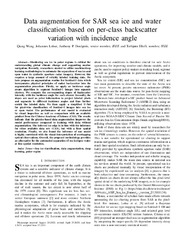Institutt for fysikk og teknologi: Recent submissions
Now showing items 181-200 of 1428
-
Synthetic wavelength scanning interferometry for 3D surface profilometry with extended range of height measurement using multi-colour LED light sources
(Journal article; Tidsskriftartikkel; Peer reviewed, 2023-04-05)We report three-dimensional surface profilometry with extended range of height measurements using synthetic wavelength scanning interferometry without tunable filters, wavelength-tuning lasers, grating elements. We have used inexpensive multiple colour light emitting diodes (LEDs) and operate them sequentially one by one or combination of two or more colours simultaneously to visualize synthetic ... -
Data Augmentation for SAR Sea Ice and Water Classification Based on Per-Class Backscatter Variation With Incidence Angle
(Journal article; Tidsskriftartikkel; Peer reviewed, 2023-07-03)Monitoring sea ice in polar regions is critical for understanding global climate change and supporting marine navigation. Recently, researchers started to utilize machine/deep learning methodologies to automate the separation of sea ice and open water in synthetic aperture radar imagery. However, this requires a large amount of reliably labeled training data. We here propose an augmentation routine ... -
Airborne Investigation of Quasi-Specular Ku-Band Radar Scattering for Satellite Altimetry Over Snow-Covered Arctic Sea Ice
(Journal article; Tidsskriftartikkel; Peer reviewed, 2023-09-22)Surface-based Ku-band radar altimetry investigations indicate that the radar signal is typically backscattered from well above the snow–sea ice interface. However, this would induce a bias in satellite altimeter sea ice thickness retrievals not reflected by buoy validation. Our study presents a mechanism to potentially explain this paradox: probabilistic quasi-specular radar scattering from the ... -
On the Control of Northern Hemispheric Feedbacks by AMOC: Evidence from CMIP and Slab Ocean Modeling
(Journal article; Tidsskriftartikkel; Peer reviewed, 2023-09-06)The climate sensitivity of Earth and the radiative climate feedback both change over time as a result of a so-called “pattern effect,” i.e., changing patterns of surface warming. This is suggested by numerical climate model experiments. The Atlantic meridional overturning circulation (AMOC) influences surface warming patterns as it redistributes energy latitudinally. Thus, this ocean circulation may ... -
Changes in the North Pacific Jet Stream in Recent Decades
(Journal article; Tidsskriftartikkel; Peer reviewed, 2023-11-25)Changes in the path and intensity of jet streams have major impacts on regional weather and climate patterns. We investigated changes in the intensity, meridional position, and altitude of the North Pacific jet in different seasons during the period 1979–2020 using the European Centre for Medium-Range Weather Forecasts (ECMWF) fifth-generation reanalysis (ERA5) dataset. Our analysis indicates that ... -
Single-shot multispectral quantitative phase imaging of biological samples using deep learning
(Journal article; Tidsskriftartikkel; Peer reviewed, 2023-05-16)Multispectral quantitative phase imaging (MS-QPI) is a high-contrast label-free technique for morphological imaging of the specimens. The aim of the present study is to extract spectral dependent quantitative information in single-shot using a highly spatially sensitive digital holographic microscope assisted by a deep neural network. There are three different wavelengths used in our method: 𝜆=532 , ... -
The Distribution of Small-Scale Irregularities in the E-Region, and Its Tendency to Match the Spectrum of Field-Aligned Current Structures in the F-Region
(Journal article; Tidsskriftartikkel; Peer reviewed, 2023-04-16)We associate new data from icebear, a coherent scatter radar located in Saskatchewan, Canada, with scale-dependent physics in the ionosphere. We subject the large-scale icebear 3D echo patterns (treated as 2D point clouds) to a data analysis technique hitherto never applied to the ionosphere, a technique that is widely applied in cosmological red-shift surveys to characterize the spatial clustering ... -
Federated Partially Supervised Learning With Limited Decentralized Medical Images
(Journal article; Tidsskriftartikkel; Peer reviewed, 2022-12-20)Data government has played an instrumental role in securing the privacy-critical infrastructure in the medical domain and has led to an increased need of federated learning (FL). While decentralization can limit the effectiveness of standard supervised learning, the impact of decentralization on partially supervised learning remains unclear. Besides, due to data scarcity, each client may have access ... -
Strongly intermittent far scrape-off layer fluctuations in Alcator C-Mod plasmas close to the empirical discharge density limit
(Journal article; Tidsskriftartikkel; Peer reviewed, 2023-09-07)Intermittent plasma fluctuations in the boundary region of the Alcator C-Mod device were comprehensively investigated using data time-series from gas puff imaging and mirror Langmuir probe diagnostics. Fluctuations were sampled during stationary plasma conditions in ohmically heated, lower single null diverted configurations with scans in both line-averaged density and plasma current, with Greenwald ... -
On the Effects of Self-supervision and Contrastive Alignment in Deep Multi-view Clustering
(Journal article; Tidsskriftartikkel; Peer reviewed, 2023-08-22)Self-supervised learning is a central component in recent approaches to deep multi-view clustering (MVC). However, we find large variations in the development of self-supervision-based methods for deep MVC, potentially slowing the progress of the field. To address this, we present Deep-MVC, a unified framework for deep MVC that includes many recent methods as instances. We leverage our framework to ... -
Supercm: Revisiting Clustering for Semi-Supervised Learning
(Journal article; Tidsskriftartikkel; Peer reviewed, 2023-05-05)The development of semi-supervised learning (SSL) has in recent years largely focused on the development of new consistency regularization or entropy minimization approaches, often resulting in models with complex training strategies to obtain the desired results. In this work, we instead propose a novel approach that explicitly incorporates the underlying clustering assumption in SSL through extending ... -
Using a large open clinical corpus for improved ICD-10 diagnosis coding
(Journal article; Tidsskriftartikkel, 2023)With the recent advances in natural language processing and deep learning, the development of tools that can assist medical coders in ICD-10 diagnosis coding and increase their efficiency in coding discharges ummaries is significantly more viable than before. To that end, one important component in the development of these models is the datasets used to train them. In this study, such datasets are ... -
Optical trapping in air on a single interference fringe
(Journal article; Tidsskriftartikkel, 2023)Stable and reproducible trapping in air of 1 µm and 500 nm dielectric particles has been realized using a dual beam optical fiber tweezers with cleaved commercial single mode fibers. The influence of the interference fringes of the two coherent and counter-propagating trapping beam is investigated by controlling the fringe visibility. Optical trapping on a series of upto10 fringes or trapping on ... -
The Meta-Evaluation Problem in Explainable AI: Identifying Reliable Estimators with MetaQuantus
(Journal article; Tidsskriftartikkel, 2023)Explainable AI (XAI) is a rapidly evolving field that aims to improve transparency and trustworthiness of AI systems to humans. One of the unsolved challenges in XAI is estimating the performance of these explanation methods for neural networks, which has resulted in numerous competing metrics with little to no indication of which one is to be preferred. In this paper, to identify the most reliable ... -
DiffCloth: Diffusion Based Garment Synthesis and Manipulation via Structural Cross-modal Semantic Alignment
(Journal article; Tidsskriftartikkel; Peer reviewed, 2024-01-15)Cross-modal garment synthesis and manipulation will significantly benefit the way fashion designers generate garments and modify their designs via flexible linguistic interfaces. However, despite the significant progress that has been made in generic image synthesis using diffusion models, producing garment images with garment part level semantics that are well aligned with input text prompts and ... -
Coordinate Transformer: Achieving Single-stage Multi-person Mesh Recovery from Videos
(Journal article; Tidsskriftartikkel; Peer reviewed, 2024-01-15)Multi-person 3D mesh recovery from videos is a critical first step towards automatic perception of group behavior in virtual reality, physical therapy and beyond. However, existing approaches rely on multi-stage paradigms, where the person detection and tracking stages are performed in a multi-person setting, while temporal dynamics are only modeled for one person at a time. Consequently, their ... -
Exploring the Potential of Sentinel-1 Ocean Wind Field Product for Near-Surface Offshore Wind Assessment in the Norwegian Arctic
(Journal article; Tidsskriftartikkel; Peer reviewed, 2024-01-24)The exploitation of offshore wind resources is a crucial step towards a clean energy future. It requires an advanced approach for high-resolution wind resource evaluations. We explored the suitability of the Sentinel-1 Level-2 OCN ocean wind field (OWI) product for offshore wind resource assessments. The SAR data were compared to in situ observations and three reanalysis products: the global ... -
A Comparison Between Oil-to-Water Volumetric Fractions Derived from L-Band Synthetic Aperture Radar Imagery and in Situ Samples
(Journal article; Tidsskriftartikkel; Peer reviewed, 2023-10-20)We compare in-situ water volume measurements of mineral oil emulsion sampled from an oil slick in Santa Barbara, California, to acquisitions of airborne UAVSAR data acquired in June 2022. Estimating the water-to-oil fraction using the UAVSAR imagery, we find that low SNR in the co- and cross-polarimetric channels limits this capability above a certain oil-to-water volumetric threshold. Higher SNR ... -
Hubs and Hyperspheres: Reducing Hubness and Improving Transductive Few-shot Learning with Hyperspherical Embeddings
(Journal article; Tidsskriftartikkel; Peer reviewed, 2023-08-22)Distance-based classification is frequently used in transductive few-shot learning (FSL). However, due to the high-dimensionality of image representations, FSL classifiers are prone to suffer from the hubness problem, where a few points (hubs) occur frequently in multiple nearest neighbour lists of other points. Hubness negatively impacts distance-based classification when hubs from one class appear ... -
Analysis of dust impacts observed with the Radio Plasma Wave instrument onboard ESA’s Solar Orbiter
(Master thesis; Mastergradsoppgave, 2023-12-15)Dust particles are one of the major constituents of the interplanetary medium in our solar system. They are presumably formed by fragmentation processes of meteoroids and for a certain range of sizes and parameters the dust particles move radially outwards from the Sun. The Radio plasma Wave (RPW) instrument on Solar Orbiter can measure dust particles that impact the spacecraft. By measuring the ...


 English
English norsk
norsk


















